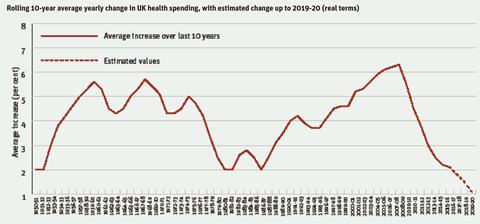The NHS cannot wait much longer for an answer on how to fix its deteriorating finances. If this government wants to make good on its rhetoric it must find a way for the NHS to access funding from outside the exchequer

November’s comprehensive spending review looms large in the minds of all NHS leaders. How much will the service get and crucially when will it arrive and with what strings attached?

The consistent message is that the service will receive the £8bn promised and not a penny more. If that proves to be the case, two conclusions can be reached.
First, thank heaven for the £8bn - some now blame NHS England chief executive Simon Stevens for convincing the Treasury the NHS could survive on that sum, but given the context of the national finances and government policy, winning that commitment should still be applauded.
But the second conclusion is that, as every passing day highlights more brightly, the £8bn will be inadequate if not accompanied by other financial strategies.
Analysis produced by the Health Foundation (see graph above and caveats below) shows the 10 year rolling average of NHS funding has plunged and by the end of this Parliament will be at a historic 55 year low, even after the £8bn injection.
- Provider deficits swell to £930m in three months
- Five things we learnt from the Tory party conference
- Acute trust stretch targets would cut deficit by only 16pc
- Trusts continue to forecast £2bn deficit as overspending worsens
The party of the NHS
At this week’s Conservative Party conference Jeremy Hunt repeated his claim that he wants “the Conservative Party to be the party of the NHS”. It is a bold ambition, but requires a fix for the service’s finances.
Does that mean more cash? Well, every little helps, but the Health Foundation calculates even getting NHS funding back to the historic annual average increase of 3.7 per cent would mean finding another £10bn on top of that already promised.
That would be a stretch, even for a government not committed to rapid reduction of the national deficit.
‘The NHS cannot wait much longer for robust answers’
The answer will not be provided by initiatives with high profiles but relatively tiny budgets or counter-productive raids on the capital budget. Nor should we pay any attention to the zombie policy ideas of user charging.
Let us also recognise the efficiency drive is an essential part of meeting this challenge - but not the solution in itself.
The government must find a way for the NHS to access significant capital finance from outside the exchequer - banks, pension funds or other private lenders, for example - to rapidly accelerate investment in new facilities and technology, therefore creating the environment in which new care models can start to make an impact. It must, of course, do so while avoiding the kind of problems created by private finance initiatives.
No easy task and little wonder Mr Hunt avoided mentioning the NHS deficit in his conference speech. But the NHS cannot wait much longer for robust answers.
Graph caveats: 1) GDP deflator for years between 1949-50 and 1954-55 are estimated by the Health Foundation. 2) Values for 2015-16 to 2019-20 are estimated by applying the average cash terms increase for the English NHS of receiving an extra £8bn in real terms by 2020-21 in accordance with the Conservative Party manifesto, to the UK figure. Data: Author’s calculations, using data from Public Sector Statistical Analyses 2015 (HM Treasury), Fiscal Facts: Spending by Function (Institute of Fiscal Studies), OHE Guide to UK Health and Health Care Statistics 2013 (Office of Health Economics, Hawe E and Cockcroft L), Quarterly National Accounts, Quarter 2 (Apr to June) 2015 Dataset (Office for National Statistics), GDP deflators at market prices, and money GDP September 2015 (HM Treasury)
Updated: Provider deficits swell to £930m in three months

The NHS provider sector has reported a combined deficit of £930m for the first three months of 2015-16, which is more than the entire deficit reported last year.
- 1
 Currently
reading
Currently
reading
We have to talk about the money






























30 Readers' comments